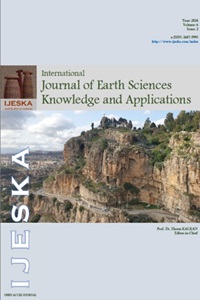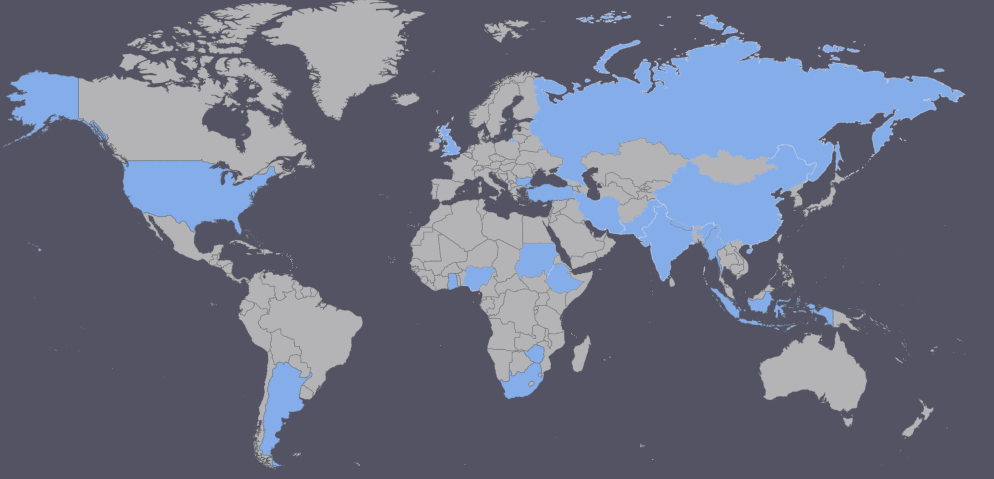Impact of Land Use and Land Cover Changes on Groundwater Dynamics in Selected Local Government Areas of Anambra State, Nigeria
Keywords:
Change Detection Analysis, Digital Elevation Models (DEMs), Sentinel-2 Imagery, Terrain Slope, Urbanization ImpactsAbstract
This research investigates the shifts in Land Use and Land Cover (LULC) patterns from 2017 to 2023 and their impact on groundwater resources. The objective is to evaluate how these changes affect groundwater recharge, quality, and availability. Utilizing LULC data sourced from Sentinel-2 imagery and Digital Elevation Models (DEMs) from the Shuttle Radar Topography Mission (SRTM), the study employs supervised classification methods to categorize LULC classes. Terrain slope analysis offers insights into water flow dynamics and soil stability. The findings reveal substantial alterations in LULC types during the study period, predominantly driven by urban expansion and agricultural intensification. Notable changes include declines in tree cover and flooded vegetation, alongside expansions in built-up and agricultural areas. These shifts have significant implications for groundwater recharge, impacting both its availability and quality. Urbanization and agricultural growth emerge as key drivers of change, leading to diminished natural recharge zones, heightened surface runoff, and increased contamination risks. Moreover, the influence of terrain slope adds complexity to groundwater dynamics, affecting water movement and soil integrity. The study emphasizes the critical importance of adopting sustainable land management practices and strategic urban planning to safeguard groundwater resources. It underscores the intricate relationship between land use alterations, terrain characteristics, and groundwater dynamics, highlighting the necessity for targeted management approaches to enhance groundwater recharge and preserve its quality amidst evolving environmental challenges.
References
Akaolisa, C. C. Z., Ibeneche, W., Ibeneme, S., Agbasi, O., & Okechukwu, S. (2022). Enhance groundwater quality assessment using integrated vertical electrical sounding and physio-chemical analyses in Umuahia South, Nigeria. International Journal of Energy and Water Resources. https://doi.org/10.1007/s42108-022-00219-8
Akaolisa, C. C., Agbasi, O. E., Etuk, S. E., Adewumi, R., & Okoli, E. A. (2023). Evaluating the Effects of Real Estate Development in Owerri, Imo State, Nigeria: Emphasizing Changes in Land Use/Land Cover (LULC). Journal of Landscape Ecology, 16(2), 98–113. https://doi.org/10.2478/jlecol-2023-0012
Ashaolu, E. D., Olorunfemi, J. F., Ifabiyi, I. P., Abdollahi, K., & Batelaan, O. (2020). Spatial and temporal recharge estimation of the basement complex in Nigeria, West Africa. Journal of Hydrology. Regional Studies, 27, 100658. https://doi.org/10.1016/j.ejrh.2019.100658
Awomeso, J. A., Ahmad, S. M., & Taiwo, A. M. (2020). Multivariate assessment of groundwater quality in the basement rocks of Osun State, Southwest, Nigeria. Environmental Earth Sciences, 79(5). https://doi.org/10.1007/s12665-020-8858-z
Chinye-Ikejiunor, N., Iloegbunam, G. O., Chukwuka, A., & Ogbeide, O. (2021). Groundwater contamination and health risk assessment across an urban gradient: Case study of Onitcha metropolis, south-eastern Nigeria. Groundwater for Sustainable Development, 14, 100642. https://doi.org/10.1016/j.gsd.2021.100642
Chukwura, U. O., & Igwe, O. (2021). Seasonal evaluation of the hydrogeochemical interpretations of groundwater quality: a case study from automobile junk waste in Obosi and Onitsha environs, Southeast Nigeria. Arabian Journal of Geosciences, 14(4). https://doi.org/10.1007/s12517-021-06643-0
Csicsaiova, R., Marko, I., Stanko, S., Skultetyova, I., & Hrudka, J. (2020). Impact of stormwater runoff in the urbanized area. IOP Conference Series. Earth and Environmental Science, 444(1), 012008. https://doi.org/10.1088/1755-1315/444/1/012008
De Andrade Caxito, F., De Lira Santos, L. C. M., Ganade, C. E., Bendaoud, A., Fettous, E. H., & Bouyo, M. H. (2020). Toward an integrated model of geological evolution for NE Brazil-NW Africa: The Borborema Province and its connections to the Trans-Saharan (Benino-Nigerian and Tuareg shields) and Central African orogens. Brazilian Journal of Geology, 50(2). https://doi.org/10.1590/2317-4889202020190122
Egbueri, J. C., Ezugwu, C. K., Unigwe, C. O., Onwuka, O. S., Onyemesili, O. C., & Mgbenu, C. N. (2020). Multidimensional Analysis of the Contamination Status, Corrosivity and Hydrogeochemistry of Groundwater from Parts of the Anambra Basin, Nigeria. Analytical Letters, 1–31. https://doi.org/10.1080/00032719.2020.1843049
Eludoyin, A. O., & Adewole, A. O. (2019). A remote sensing-based evaluation of an ungauged drainage basin in Southwestern Nigeria. International Journal of River Basin Management, 18(3), 307–319. https://doi.org/10.1080/15715124.2019.1640226
Garba, H., & Abubakar, Z. (2023). Effect of Slope and Runoff Trends on the Hydrological Response of River Kaduna. ABUAD Journal of Engineering Research and Development, 6(2), 183–191. https://doi.org/10.53982/ajerd.2023.0602.18-j
George, N. J., Agbasi, O. E., Umoh, J. A., Ekanem, A. M., Ejepu, J. S., Thomas, J. E., & Udoinyang, I. E. (2022). Contribution of electrical prospecting and spatiotemporal variations to groundwater potential in coastal hydro-sand beds: a case study of Akwa Ibom State, Southern Nigeria. Acta Geophysica, 71(5), 2339–2357. https://doi.org/10.1007/s11600-022-00994-2
He, S., Li, P., Wu, J., Elumalai, V., & Adimalla, N. (2019). Groundwater quality under land use/land cover changes: A temporal study from 2005 to 2015 in Xi’an, Northwest China. Human and Ecological Risk Assessment, 26(10), 2771–2797. https://doi.org/10.1080/10807039.2019.1684186
Ibe, F. C., Opara, A. I., Amaobi, C. E., & Ibe, B. O. (2021). Environmental risk assessment of the intake of contaminants in aquifers in the vicinity of a reclaimed waste dumpsite in Owerri municipal, Southeastern Nigeria. Applied Water Science, 11(2). https://doi.org/10.1007/s13201-020-01355-4
Ifeanyichukwu, K. A., Okeyeh, E., Agbasi, O. E., Moses, O. I., & Ben-Owope, O. (2021). Using Geo-electric Techniques for Vulnerability and Groundwater Potential Analysis of Aquifers in Nnewi, South Eastern Nigeria. Journal of Geology, Geography and Geoecology, 30(1), 43–52. https://doi.org/10.15421/112105
Ijioma, U. D. (2021). Delineating the impact of urbanization on the hydrochemistry and quality of groundwater wells in Aba, Nigeria. Journal of Contaminant Hydrology, 240, 103792. https://doi.org/10.1016/j.jconhyd.2021.103792
Jabir, A., Yusuf, Y., & Jibrin, A. (2022). Physicochemical and Bacteriological Analysis of Groundwater Quality in Lower Kubanni River Basin Zaria, Nigeria. Arid Zone Journal of Basic and Applied Research, 1(1). https://doi.org/10.55639/607ihg
Khan, R. M. A., Sohail, A., Gillani, S. A., Hassan, S. S., & Mahmood, S. A. (2020). Active Surface deformation from DEM Based Surface Dynamics in Upstream of Mangla Reservoir and eastern Potwar Plateau. International Journal of Innovations in Science and Technology, 2(2), 51–60. https://doi.org/10.33411/ijist/2020020203
Lasisi, M. O., Omotayo, K. F., & Adeosun, Y. M. (2022). Application of Geographic Information System and Remote Sensing in Groundwater Recharge Potential of Ado-Ekiti, Nigeria. International Journal of Agriculture, Environment and Bioresearch, 07(03), 215–226. https://doi.org/10.35410/ijaeb.2022.5737
Li, C., Sun, G., Caldwell, P. V., Cohen, E., Fang, Y., Zhang, Y., Oudin, L., Sanchez, G. M., & Meentemeyer, R. K. (2020). Impacts of Urbanization on Watershed Water Balances Across the Conterminous United States. Water Resources Research, 56(7). https://doi.org/10.1029/2019wr026574
Naz, R., Ashraf, A., Van Der Tol, C., & Aziz, F. (2020). Modeling hydrological response to land use/cover change: case study of Chirah Watershed (Soan River), Pakistan. Arabian Journal of Geosciences, 13(22). https://doi.org/10.1007/s12517-020-06177-x
Ogar, E. C. V., Adie, A. D., & Al, U. B. O. E. (2022). Livelihood Activities, Climate Change and Water Resources Availability in the Lower Cross River State, Nigeria. Journal of Agriculture and Crops, 83, 216–227. https://doi.org/10.32861/jac.83.216.227
Ogbe, O. B., & Osokpor, J. (2021). Depositional facies, sequence stratigraphy and reservoir potential of the Eocene Nanka Formation of the Ameki Group in Agu-Awka and Umunya, southeast Nigeria. Heliyon, 7(1), e05846. https://doi.org/10.1016/j.heliyon.2020.e05846
Ogungbade, O., Ariyo, S. O., Alimi, S. A., Alepa, V. C., Aromoye, S. A., & Akinlabi, O. J. (2022). A combined GIS, remote sensing and geophysical methods for groundwater potential assessment of Ilora, Oyo central, Nigeria. Environmental Earth Sciences, 81(3). https://doi.org/10.1007/s12665-022-10199-x
Olabode, O. F., & Comte, J. C. (2022). Modelling of groundwater recharge in the megacity of Lagos, Nigeria: preliminary results using WetSpass-M. Advances in Geosciences, 59, 53–57. https://doi.org/10.5194/adgeo-59-53-2022
Omoyemi, A. O. (2023). An assessment of the effects of deforestation on biodiversity in OJO local government area of Lagos State, Nigeria. Global Journal of Ecology, 8(2), 075–080. https://doi.org/10.17352/gje.000085
Onanuga, M. Y., Eludoyin, A. O., & Ofoezie, I. E. (2021). Urbanization and its effects on land and water resources in Ijebuland, southwestern Nigeria. Environment, Development and Sustainability, 24(1), 592–616. https://doi.org/10.1007/s10668-021-01458-1
Prancevic, J. P., Lamb, M. P., McArdell, B. W., Rickli, C., & Kirchner, J. W. (2020). Decreasing Landslide Erosion on Steeper Slopes in Soil‐Mantled Landscapes. Geophysical Research Letters, 47(10). https://doi.org/10.1029/2020gl087505
Rahman, A., Abdullah, H. M., Tanzir, M. T., Hossain, M. J., Khan, B. M., Miah, M. G., & Islam, I. (2020). Performance of different machine learning algorithms on satellite image classification in rural and urban setup. Remote Sensing Applications, 20, 100410. https://doi.org/10.1016/j.rsase.2020.100410
Rowland, A., & Agbasi, O. E. (2024). Assessing the Impact of Land Cover and Land Use Change on Urban Infrastructure Resilience in Abuja, Nigeria: A Case Study From 2017 To 2022. Structure and Environment, 16(1), 6–17. https://doi.org/10.30540/sae-2024-002
Sikakwe, G. U. (2020). Geospatial applications in delineating groundwater prospect zones in a hard rock terrain: an integrated approach. Environmental Earth Sciences, 79(21). https://doi.org/10.1007/s12665-020-09235-5
Triana, J. S. A., Chu, M. L., Guzman, J. A., Moriasi, D. N., & Steiner, J. L. (2020). Evaluating the Risks of Groundwater Extraction in an Agricultural Landscape under Different Climate Projections. Water, 12(2), 400. https://doi.org/10.3390/w12020400
Ukpai, S. N., Ojobor, R. G., Okogbue, C. O., Nnabo, P. N., Oha, A. I., Ekwe, A. C., & Nweke, M. O. (2021). Socio-economic influence of hydrogeology in regions adjoining coal bearing formation: Water policy in Anambra Basin. Water Policy. https://doi.org/10.2166/wp.2021.275
Weatherl, R. K., Salgado, M. J. H., Ramgraber, M., Moeck, C., & Schirmer, M. (2021). Estimating surface runoff and groundwater recharge in an urban catchment using a water balance approach. Hydrogeology Journal, 29(7), 2411–2428. https://doi.org/10.1007/s10040-021-02385-1
Wudineh, F. A. (2023). Land-use and land-cover change and its impact on flood hazard occurrence in Wabi Shebele River Basin of Ethiopia. Nordic Hydrology, 54(6), 756–769. https://doi.org/10.2166/nh.2023.121
Zacchaeus, O. O., Adeyemi, M. B., Adedeji, A. A., Adegoke, K. A., Anumah, A. O., Taiwo, A. M., & Ganiyu, S. A. (2020). Effects of industrialization on groundwater quality in Shagamu and Ota industrial areas of Ogun state, Nigeria. Heliyon, 6(7), e04353. https://doi.org/10.1016/j.heliyon.2020.e04353
Downloads
Published
Issue
Section
License
Copyright (c) 2024 Ifeanyi Benard Odoh, Nkiru Charity Nwokeabia

This work is licensed under a Creative Commons Attribution-NonCommercial-NoDerivatives 4.0 International License.
The authors keep the copyrights of the published materials with them, but the authors are aggee to give an exclusive license to the publisher that transfers all publishing and commercial exploitation rights to the publisher. The puslisher then shares the content published in this journal under CC BY-NC-ND license.



